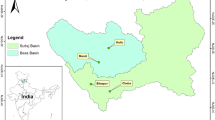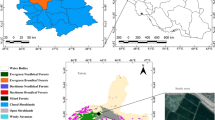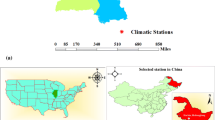Abstract
Calculation of reference evapotranspiration (ETo) is essential in hydrology and agriculture. ETo plays an important role in planning and management of water resources and irrigation scheduling. The results of many studies strongly support the use of the Penman–Monteith FAO 56 (PMF-56) method as the standard method of estimating ETo. The basic obstacle to using this method widely is the numerous meteorological variables required. Multilayer perceptron (MLP) networks optimized with different learning algorithms and activation functions were applied for estimating ETo in a semiarid region in Iran. Four MLP models comprising various combinations of meteorological variables are developed. The MLP model which needs all of the meteorological parameters performed best for ETo estimation amongst the other MLP models. It was also found that the ConjugateGradient, DeltaBarDelta, DeltaBarDelta and Levenberg–Marquardt were the best algorithms for training the MLP1, MLP2, MLP3 and MLP4 models, respectively.






Similar content being viewed by others
References
Allen RG, Periera LS, Raes D, Smith M (1998) Crop evapotranspiration: guideline for computing crop water requirement. FAO Irrigation and drainage Paper No. 56, FAO, Rome
Anyadike RNC (1987) The Lincare evaporation formula tested and compared to others in various climates over West Africa. Agric For Meteorol 39(2–3):111–119
Aytek A (2009) Co-active neurofuzzy inference system for evapotranspiration modeling. Soft Comput 13(7):691–700
Barnett N, Madramootoo CA, Perrone J (1998) Performance of some evapotranspiration equations at a site in Quebec. Can Agric Eng 40(2):89–95
Caudill M, Butler C (1992) Understanding neural networks: volume 1: basic networks. The MIT Press, Cambridge
Chauhan S, Shrivastava RK (2009) Performance evaluation of reference evapotranspiration estimation using climate based methods and artificial neural networks. Water Resour Manage 23(5):825–837
Dingman SL (1994) Physical hydrology. Prentice Hall, Upper Saddle River
Jahanbani H, El-Shafie AH (2011) Application of artificial neural network in estimating monthly time series reference evapotranspiration with minimum and maximum temperatures. Paddy Water Environ, 9(2):207–220
Hansen VE, Israelsen OW, Stringham GE (1980) Irrigation principles and practices, 4th edn. Wiley, New York
Hosseinzadeh Talaee P, Heydari M, Fathi P, Marofi S, Tabari H (2011) Numerical model and computational intelligence approaches for estimating flow through rockfill dam. J Hydrol Eng ASCE. doi:10.1061/(ASCE)HE.1943-5584.0000446
Kim S, Kim HS (2008) Neural networks and genetic algorithm approach for nonlinear evaporation and evapotranspiration modeling. J Hydrol 351:299–317
Kisi Ö (2006) Generalized regression neural networks for evapotranspiration modeling. Hydrol Sci J 51:1092–1105
Kisi Ö (2007) Evapotranspiration modeling from climatic data using a neural computing technique. Hydrol Process 21(6):1925–1934
Kisi Ö (2008) The potential of different ANN techniques in evapotranspiration modeling. Hydrol Process 22:2449–2460
Kumar M, Raghuwanshi NS, Singh R, Wallender WW, Pruitt WO (2002) Estimating evapotranspiration using artificial neural network. J Irrg Drain Eng 128(4):224–233
Laaboudi A, Mouhouche B, Draoui B (2011) Neural network approach to reference evapotranspiration modeling from limited climatic data in arid regions. Int J Biometeorol. doi:10.1007/s00484-011-0485-7
Landeras G, Ortiz-Barredo A, Lopez JJ (2008) Comparison of artificial neural network models and empirical and semi-empirical equations for daily reference evapotranspiration estimation in the Basque Country (Northern Spain). Agr Water Manage 95:553–565
Lopez-Urrea R, de Santa Martın, Olalla F, Fabeiro C, Moratalla A (2006) Testing evapotranspiration equations using lysimeter observations in a semiarid climate. Agr Water Manage 85:15–26
Marofi S, Tabari H, Zare Abyaneh H (2011) Predicting spatial distribution of snow water equivalent using multivariate non-linear regression and computational intelligence methods. Water Resour Manage 25(5):1417–1435
Martí P, González-Altozano P, Gasque M (2011) Reference evapotranspiration estimation without local climatic data. Irrig Sci 29(6):479–495
NeuroDimension Inc (2005) Developers of NeuroSolutions v5.01: neural network simulator. The World Wide Web address is http://www.nd.com, Gainesville
NeuroSolutions Manual (2003) The neural network simulation environment. NeuroDimension Inc., FL
Qiu GY, Miyamoto K, Sase S, Gao Y, Shi P, Yano T (2002) Comparison of the three-temperature model and conventional models for estimating transpiration. JPN Agric Res Quart 36(2):73–82
Raju KS, Kumar DN, Duckstein L (2006) Artificial neural networks and multicriterion analysis for sustainable irrigation planning. Comput Oper Res 33:1138–1153
Rezaeian-Zadeh M, Tabari H (2012) MLP-based drought forecasting in different climatic regions. Theor Appl Climatol. doi:10.1007/s00704-011-0568-8
Rezaeian-Zadeh M, Tabari H, Abghari H (2011) Prediction of monthly discharge volume by different artificial neural network algorithms in semi-arid regions. Arab J Geosci. doi:10.1007/s12517-011-0517-y
Sudheer KP, Gosain AK, Ramasastri KS (2003) Estimating actual evapotranspiration from limited climate data using neural computing technique. J Irrg Drain Eng 129(3):214–218
Tabari H (2010) Evaluation of reference crop evapotranspiration equations in various climates. Water Resour Manage 24:2311–2337
Tabari H, Grismer ME, Trajkovic S (2011) Comparative analysis of 31 reference evapotranspiration methods under humid conditions. Irrig Sci. doi:10.1007/s00271-011-0295-z
Tabari H, Hosseinzadeh Talaee P (2011) Local calibration of the Hargreaves and Priestley–Taylor equations for estimating reference evapotranspiration in arid and cold climates of Iran based on the Penman-Monteith model. J Hydrol Engin 16(10):837–845
Tabari H, Marofi S, Sabziparvar AA (2010) Estimation of daily pan evaporation using artificial neural network and multivariate non-linear regression. Irrig Sci 28:399–406
Tabari H, Marofi S, Zare Abyaneh H, Sharifi MR (2010) Comparison of artificial neural network and combined models in estimating spatial distribution of snow depth and snow water equivalent in Samsami basin of Iran. Neural Comput Applic 19:625–635
Tabari H, Sabziparvar AA, Ahmadi M (2011) Comparison of artificial neural network and multivariate linear regression methods for estimation of daily soil temperature in an arid region. Meteor Atmos Phys 110:135–142
Torres M, Hervas C, Amador F (2005) Approximating the sheep milk production curve through the use of artificial neural networks and genetic algorithms. Comput Oper Res 32:2653–2670
Trajkovic S (2009) Comparison of radial basis function networks and empirical equations for converting from pan evaporation to reference evapotranspiration. Hydrol Process 23:874–880
Trajkovic S, Todorovic B, Stankovic M (2003) Forecasting reference evapotranspiration by artificial neural networks. J. Irrig Drain Eng ASCE 129(6):454–457
Acknowledgments
The authors would like to thank the Islamic Republic of Iran Meteorological Organization (IRIMO) for providing the requisite meteorological data.
Author information
Authors and Affiliations
Corresponding author
Rights and permissions
About this article
Cite this article
Tabari, H., Hosseinzadeh Talaee, P. Multilayer perceptron for reference evapotranspiration estimation in a semiarid region. Neural Comput & Applic 23, 341–348 (2013). https://doi.org/10.1007/s00521-012-0904-7
Received:
Accepted:
Published:
Issue Date:
DOI: https://doi.org/10.1007/s00521-012-0904-7




